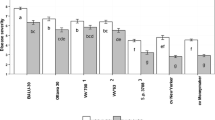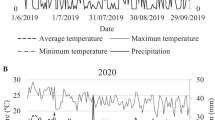Abstract
Epidemics of late blight on potato in the semiarid Pacific Northwest since 1991 have been characterized by a prevalence of stem lesions in relation to leaf lesions. This study was conducted in 1997 to test the hypothesis that isolates representing immigrant strains of Phytophthora infestans were more adapted at causing stem lesions and more aggressive at higher temperatures than isolates representing the relatively older US-1 strain. A total of 23 Phytophthora infestans isolates representing US-1, US-8, and a new A1 compatibility type strain were tested for aggressiveness on leaflets and stems of whole potato plants (cv. Russet Burbank) in 11 trials. Plants in one set of trials were incubated at constant temperatures of 18, 23, and 28 °C for six days with a 16 h photoperiod. Plants in the second set of trials were incubated at the same three day temperatures but the night temperature in all treatments was reduced to 16 °C. Lesion establishment was recorded, and daily severity readings were used to calculate the area under the lesion expansion curve (AULEC). Lesion area, sporulation frequency, sporulation time, and sporulation capacity were also measured. Lesion establishment was higher on stems than on leaves for isolates of all strains. Isolates representing US-8 and new A1 strains often had higher AULEC values but had similar lesion establishment, sporulation frequency, sporulation time, and sporulation capacity values as US-1 isolates. A reduction in components of aggressiveness for all strains was noted at 28 °C, with leaflets being more affected than stems. Sporulation rarely occurred at 28 °C. Few differences in components of aggressiveness were observed between 18 and 23 °C. These findings indicate that isolates from the relatively newer strains (US-8 and new A1) were not better adapted in causing lesions on potato stems than isolates from the old US-1 strain, nor were they better adapted to higher temperatures. The relatively newer strains, however, were generally more aggressive as indicated by higher AULEC on stems and leaflets over the range of temperatures used in this experiment.
Resumen
Las epidemias del tizón tardío de la papa en el Pacífico Noroccidental semiárido desde 1991 han sido caracterizadas por una prevalencia de lesiones del tallo sobre las de hoja. Este estudio se efectuó en 1997 para probar la hipótesis de que los aislamientos representando variantes inmigrantes de Phytophthora infestans se adaptaron mejor causando lesiones de tallo y fueron más agresivas a temperaturas más altas que los aislamientos representando la variante relativamente más vieja de US-1. Se probó un total de 23 aislamientos de Phytophthora infestans representando US-1, US-8 y una nueva cepa de tipo de compatibilidad A1, respecto a agresividad, en pecíolos y tallos de plantas completas de papa (var. Russet Burbank) en 11 ensayos. Se incubaron plantas en un grupo de ensayos a temperaturas de 18, 23, y 28 °C por seis días con un fotoperiodo de 16 hs. Las plantas en el segundo juego de ensayos se incubaron tres días a las mismas temperaturas, pero la temperatura nocturna en todos los tratamientos se redujo a 16 °C. Se registró el establecimiento de la lesión y se usaron lecturas diarias de severidad para calcular el área bajo la curva de expansión de la lesión (AULEC). También se midieron el área de la lesión, la frecuencia, tiempo y capacidad de la esporulación. El establecimiento de la lesión fue más alto en tallos que en hojas para aislamientos de todas las variantes. Los aislamientos US-8 y el nuevo A1 a menudo tuvieron valores de AULEC más altos, pero similar valor para establecimiento de la lesión, frecuencia, tiempo y capacidad de esporulación a los US-1. Se notó una reducción en los componentes de agresividad para todas las variantes a 28 °C, con mayor afectación de los pecíolos que de los tallos. La esporulación raramente ocurrió a 28 °C. Se observaron pocas diferencias en los componentes de agresividad entre 18 y 23 °C. Estos hallazgos indican que los aislamientos de las cepas relativamente nuevas (US-8 y nuevo A1) no tuvieron mejor adaptación respecto a causar lesiones en tallos de papa que los aislamientos de la vieja cepa US-1, ni tuvieron mejor adaptación a temperaturas más altas. No obstante, las cepas relativamente más nuevas fueron generalmente más agresivas como se indica por un AULEC más alto en tallos y pecíolos sobre la amplitud de temperaturas usadas en este experimento.
Similar content being viewed by others
References
Bashan, B., D. Kadish, U. Levy, and Y. Cohen. 1989. Infectivity to potato, sporangial germination, and respiration of isolates of Phytophthora infestans from metalaxyl-sensitive and metalaxyl-resistant populations. Phytopathology 79: 832–836.
Berger, R.D., A. Bergamin Filho, and L. Amorim. 1997. Lesion expansion as an epidemic component. Phytopathology 87: 1005–1013.
Browning, J.A., M.D. Simons, and E. Torres. 1977. Managing host genes: Epidemiologic and genetic concepts. Pages 191–212 in. Plant Disease, Volume I. J. G. Horsfall and E. B. Cowling, eds. Academic Press, New York. 465 pp.
Campbell, C.L., and L.V. Madden. 1990. Introduction to Plant Disease Epidemiology. New York: John Wiley & Sons. 532 pp.
Castronovo, A.H., D. Thurston, and C.J. Eide. 1954. Parasitic aggressiveness and its relation to late blight tolerant potato varieties and the survival of the pathogen. (Abstr.) Am. Potato J 31: 366–367.
Day, J.P., and R.C. Shattock. 1997. Aggressiveness and other factors relating to displacement of populations of Phytophthora infestans in England and Wales. European Journal of Plant Pathology 103: 379–391.
Dorrance, A.E., and D.A. Inglis. 1997. Assessment of greenhouse and laboratory screening methods for evaluating potato foliage for resistance to late blight. Plant Disease 81: 1206–1213.
Dowley, L.J. 1987. Factors affecting the survival of metalaxyl resistant strains of Phytophthora infestans (Mont.) de Bary in Ireland. Potato Research 30: 473–475.
Fry, W.E., and S.B. Goodwin. 1997. Resurgence of the Irish potato famine fungus. Bioscience 47: 363–371.
Fry, W.E., S.B. Goodwin, J.M. Matuszak, L.J. Spielman, and M.G. Milgroom. 1992. Population genetics and intercontinental migrations of Phytophthora infestans. Annual Review of Phytopathology 30: 107–129.
Fry, W.E., S.B. Goodwin, A.T. Dyer, J.M. Matuszak, A. Drenth, P.W. Tooley, L.S. Sujkowski, Y.J. Koh, B.A. Cohen, L.J. Spielman, K.L. Deahl, D.A. Inglis, and K.P. Sandlan. 1993. Historical and recent migrations of Phytophthora infestans: Chronology, pathways, and implications. Plant Disease 77: 653–551.
Goodwin, S.B., A. Drenth, and W.E. Fry. 1992. Cloning and genetic analyses of two highly polymorphic, moderately repetitive nuclear DNAs from Phytophthora infestans. Current Genetics 22: 107–115.
Goodwin, S.B., B.A. Cohen, K.L. Deahl, and W.E. Fry. 1994a. Migration from northern Mexico as the probable cause of recent genetic changes in populations of Phytophthora infestans in the United States and Canada. Phytopathology 84: 553–558.
Goodwin, S.B., B.A. Cohen, and W.E. Fry. 1994b. Panglobal distribution of a single clonal lineage of the Irish potato famine fungus. Proceedings of the National Academy of Science 91: 11591–11595.
Goodwin, S.B., R.E. Schneider, and W.E. Fry. 1995. Use of cellulose acetate electrophoresis for rapid identification of allozyme genotypes of Phytophthora infestans. Plant Disease 79: 1181–1185.
Guzmán-N, J. 1964. Nature of partial resistance of certain clones of three Solanum species to Phytophthora infestans. Phytopathology 54: 1398–1404.
Hamm, P.B., T.F. Cummings, and D.A. Johnson. 2006. Comparison of deposition patterns in two programs for applying protectant fungicides to potato stems and leaves for the control of late blight (Phytophthora infestans). American Journal of Potato Res 83: 473–484.
Hamm, P.B., R.A. Boydston, C.W. Hoy, W.R. Stevenson, and P.J.S. Hutchinson. 2008. Applying pesticides. Pages 113–121 in. Potato Health Management, D.A. Johnson, Ed. American Phytopathological Society Press, St. Paul.
Hohl, H.R., and K. Iselin. 1984. Strains of Phytophthora infestans with the A2 mating type behaviour. Transactions of the British Mycological Society 83: 529–530.
Hooker, W.I. (ed.). 1981. Compendium of Potato Diseases. St. Paul, MN: American Phytopathological Society.
Johnson, D.A., and T.F. Cummings. 2009. Latent infection of potato seed tubers by Phytophthora infestans during long-term cold storage. Plan Dis. 93: 940–946.
Johnson, D.A., J.R. Alldredge, and D.L. Vakoch. 1996. Potato late blight forecasting models for the semiarid environment of south-central Washington. Phytopathology 86: 480–484.
Johnson, D.A., T.F. Cummings, P.B. Hamm, R.C. Rowe, J.S. Miller, R.E. Thornton, G.Q. Pelter, and E.J. Sorensen. 1997. Potato late blight in the Columbia Basin: An economic analysis of the 1995 epidemic. Plant Disease 81: 103–106.
Johnson, D.A., T.F. Cummings, R. Abi Ghanem, and J.R. Alldredge. 2009. Association of solar irradiance and days of precipitation with incidence of potato late blight in the semiarid environment of the Columbia Basin. Plant Disease 93: 272–280.
Johnson, D.A., P.B. Hamm, J.S. Miller, and L.D. Porter. 2012. Late blight epidemics in the Columbia Basin. In. Sustainable Potato Production: Global Case Studies. Eds Z. He, R. Larkin, W. Honeycutt. Pgs 141–162. Springer.
Kable, P.F., and D.R. MacKenzie. 1980. Survival of Phytophthora infestans in potato stem lesions at high temperatures and implications for disease forecasting. Plant Disease 64: 165–167.
Kadish, D., and Y. Cohen. 1988. Fitness of Phytophthora infestans isolates from metalaxyl-sensitive and-resistant populations. Phytopathology 78: 912–915.
Kadish, D., and Y. Cohen. 1989. Population dynamics of metalaxyl-sensitive and metalaxyl-resistant isolates of Phytophthora infestans in untreated crops of potato. Plant Pathology 38: 271–276.
Kadish, D., M. Grinberger, and Y. Cohen. 1990. Fitness of metalaxyl-sensitive and metalaxyl-resistant isolates of Phytophthora infestans on susceptible and resistant potato cultivars. Phytopathology 80: 200–205.
Kato, M., E.S. Mizubuti, S.B. Goodwin, and W.E. Fry. 1997. Sensitivity to protectant fungicides and pathogenic fitness of clonal lineages of Phytophthora infestans in the United States. Phytopathology 87: 973–978.
Knutson, D.W. 1962. Studies on the nature of field resistance of the potato to late blight. Am. Potato J. 39: 152–161.
Knutson, D.W., and C.J. Eide. 1961. Parasitic aggressiveness in Phytophthora infestans. Phytopathology 51: 286–290.
Large, E.C. 1940. The Advance of the Fungi. London: Jonathan Cape. 488 pp.
Miller, J.S., P.B. Hamm, and D.A. Johnson. 1997. Characterization of the Phytophthora infestans population in the Columbia Basin of Oregon and Washington from 1992 to 1995. Phytopathology 87: 656–660.
Miller, J.S., D.A. Johnson, and P.B. Hamm. 1998. Aggressiveness of isolates of Phytophthora infestans for the Columbia Basin of Washington and Oregon. Phytopathology 88: 190–197.
Porter, L.D., D.A. Inglis, and D.A. Johnson. 2004. Identification and characterization of resistance to Phytophthora infestans in leaves, stems, flowers, and tubers of potato clones in the Pacific Northwest. Plant Disease 88: 965–972.
Ribeiro, O.K. 1978. A Source Book of the Genus Phytophthora. Vaduz: J. Cramer.
Rotem, J., and Y. Cohen. 1974. Epidemiological patterns of Phytophthora infestans under semi-arid conditions. Phytopathology 64: 711–714.
Spielman, L.J., A. Drenth, L.C. Davidse, L.J. Sujkowski, W. Gu, P.W. Tooley, and W.E. Fry. 1991. A second world wide migration and population displacement of Phytophthora infestans? Plant Pathology 40: 422–430.
Tooley, P.W., J.A. Sweigard, and W.E. Fry. 1986. Fitness and virulence of Phytophthora infestans isolates from sexual and asexual populations. Phytopathology 76: 209–1212.
Vanderplank, J.E. 1982. Host-Pathogen Interaction in Plant Disease. New York: Academic. 207 pp.
Acknowledgments
Plant Pathology New Series 0281, Department of Plant Pathology, College of Agriculture and Home Economics Research Center, Hatch Project No. 0678, Washington State University, Pullman, WA 99164–6430, USA. We thank the USDA/ARS and the Washington Potato Commission for funding this research. We thank Philip B. Hamm for his insight and discussion which has helped shaped portions of the discussion and Dr. Richard Alldredge for advice on the statistical analysis. We also thank Tom Cummings and Dannette Vargas for technical assistance and Drs. Lori Carris, Gaylon Campbell, and Robert Thornton for their critical review of the manuscript.
Author information
Authors and Affiliations
Corresponding author
Rights and permissions
About this article
Cite this article
Miller, J.S., Johnson, D.A. Aggressiveness of Phytophthora Infestans Genotypes on Potato Stems and Leaves at Three Temperatures. Am. J. Potato Res. 91, 538–553 (2014). https://doi.org/10.1007/s12230-014-9387-7
Published:
Issue Date:
DOI: https://doi.org/10.1007/s12230-014-9387-7




